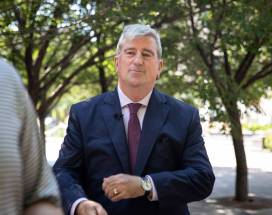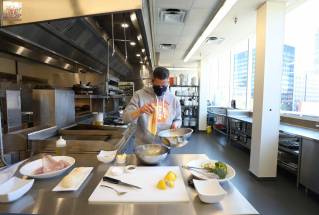Rights museum adapts as it emerges from pandemic slump
Read this article for free:
or
Already have an account? Log in here »
To continue reading, please subscribe:
Monthly Digital Subscription
$0 for the first 4 weeks*
- Enjoy unlimited reading on winnipegfreepress.com
- Read the E-Edition, our digital replica newspaper
- Access News Break, our award-winning app
- Play interactive puzzles
*No charge for 4 weeks then price increases to the regular rate of $19.00 plus GST every four weeks. Offer available to new and qualified returning subscribers only. Cancel any time.
Monthly Digital Subscription
$4.75/week*
- Enjoy unlimited reading on winnipegfreepress.com
- Read the E-Edition, our digital replica newspaper
- Access News Break, our award-winning app
- Play interactive puzzles
*Billed as $19 plus GST every four weeks. Cancel any time.
To continue reading, please subscribe:
Add Free Press access to your Brandon Sun subscription for only an additional
$1 for the first 4 weeks*
*Your next subscription payment will increase by $1.00 and you will be charged $16.99 plus GST for four weeks. After four weeks, your payment will increase to $23.99 plus GST every four weeks.
Read unlimited articles for free today:
or
Already have an account? Log in here »
Hey there, time traveller!
This article was published 28/07/2022 (1230 days ago), so information in it may no longer be current.
OTTAWA — Federal cash has kept the Canadian Museum for Human Rights afloat throughout the COVID-19 pandemic, as the Crown corporation pivots to virtual programming and tries to address discrimination under its own roof.
“We’re definitely seeing people come back,” said Riva Harrison, vice-president of community relations.
“It’s disruption prompting innovation and new ways of thinking, and I think it has positioned us well.”
The museum had a slight increase in revenue in each year of the pandemic, and didn’t have to let anyone go, thanks to federal transfer payments, accounting adjustments and attrition, despite having to close four times.
The museum ended the 2021 calendar year with $1.3 million in excess revenue, on a balance sheet of roughly $280 million. That’s just slightly less than its revenue that spring, and three times as much revenue as the museum generated in the year leading up to the pandemic.
During the fiscal year ending March 2020 , the museum made $3.3 million from ticket sales, tours, rentals and gift shop sales. A year later, that dropped 90 per cent, to about $400,000.
“We have some work to do, to remind people that we’re here and we’re a great place to visit.”–Riva Harrison
Michael Schroeder, chief financial officer, said that during that time, staff cut down on travel and conferences, which helped cover the cost of protective equipment, extra sanitation and plexiglass dividers.
“We also tried to do our part by not filling some vacancies when it made sense. So those are due to attrition and nothing drastic like layoffs; that was a big win for us,” said Schroeder.
Through amortization, the museum was able to stretch out unused government spending from past years, a practice the auditor general deemed normal.
The biggest help was $6.1 million in federal aid, delivered in two instalments as part of allocations Ottawa sent to all national museums, which generally don’t qualify for support programs such as wage subsidies.
The museum is gradually welcoming more visitors, but has well below half its normal foot traffic.
In the fiscal year that ended March 2020, just as the global pandemic was declared, the museum reported nearly 300,000 in-person visitors. Just 18,600 visits were recorded in the following fiscal year; and there were 68,000 visits in the year ending March 2022, Harrison said.
Attendance has increased since then.
“It’s uneven; it bounces around,” Harrison said. “We have some work to do, to remind people that we’re here and we’re a great place to visit.”
That’s why the museum brought back free Friday night visits last month and reopened on Sundays. The museum partners with external groups who can run programming, such as JazzFest last month, and an Aug. 5 Emancipation Day event held by local Black groups.
“We don’t want to be dependent on just any one type of visitor,” Harrison said.
The museum is deep into planning for its long-awaited digital learning centre, which will allow people to virtually participate during in-person events.
The concern, Schroeder said, is that inflation and air-travel disruption have forced people to nix travel plans, given that 70 per cent of museum visitors come from outside Manitoba. The museum expects the same funding this year as it usually gets from Parliament and a charitable foundation, with no expectation of another COVID-19 subsidy.
“Our visitation is steadily increasing. We just want to make sure we’re able to continue in that (so) we don’t plateau because of some of these other macroeconomic factors,” Schroeder said.
“We don’t want to lose that national reach and that national presence; we don’t want to lose the good that came from a very difficult situation,”–Riva Harrison
The pandemic also fast-tracked the museum’s foray into virtual school trips, which involve an interpreter hosting an interactive tour of the galleries with an entire classroom through a video link. Staff who used to facilitate in-person visits helped to launch the virtual tours.
“We pivoted fast, to the point where we sold out our schools tours this past fiscal year, so over 21,000 students from across the country, including some internationally,” said Harrison.
In-person school tours resumed this spring. After the summer break, tours will resume online and in-person. Harrison said she has “schools champing at the bit to sign up for the coming school year.”
The tours are free, thanks to funding from the Richardson and Asper family foundations. The museum will seek cash to expand those offerings.
“We don’t want to lose that national reach and that national presence; we don’t want to lose the good that came from a very difficult situation,” Harrison said.
The museum had a bumpy ride even before it opened in 2014. It opened amid concerns the land it sits on at The Forks had not been adequately excavated for Indigenous artifacts, and debates over whether it included enough content about the Holodomor famine in Ukraine or the plight of Palestinians.
In June 2020, CEO John Young resigned following allegations of racism and sexual harassment at the Crown corporation. Media revealed that staff were instructed to avoid LGBTTQ+ content during tours with groups from parochial schools and possibly some donors and diplomats.
Since then, the museum has implemented gender-neutral washrooms, equity councils of staff that advise the museum on diversity issues, and sensitivity training.
The museum recently started work on a new five-year plan, as the current one expires next year.
“That agility and that adaptation will serve us well if there are new curveballs,” Harrison said.
dylan.robertson@freepress.mb.ca





